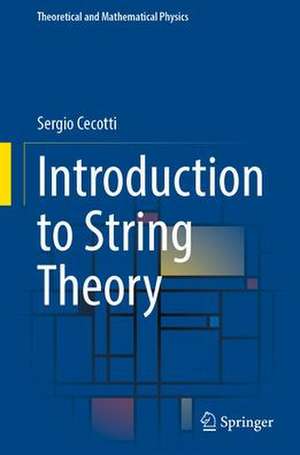Introduction to String Theory: Theoretical and Mathematical Physics
Autor Sergio Cecottien Limba Engleză Hardback – 7 oct 2023
Din seria Theoretical and Mathematical Physics
- 20%
 Preț: 697.22 lei
Preț: 697.22 lei - 18%
 Preț: 744.84 lei
Preț: 744.84 lei -
 Preț: 396.82 lei
Preț: 396.82 lei - 15%
 Preț: 721.06 lei
Preț: 721.06 lei - 18%
 Preț: 1120.68 lei
Preț: 1120.68 lei -
 Preț: 398.35 lei
Preț: 398.35 lei - 15%
 Preț: 643.65 lei
Preț: 643.65 lei - 15%
 Preț: 508.60 lei
Preț: 508.60 lei - 20%
 Preț: 652.54 lei
Preț: 652.54 lei - 15%
 Preț: 646.75 lei
Preț: 646.75 lei - 15%
 Preț: 654.12 lei
Preț: 654.12 lei - 15%
 Preț: 649.87 lei
Preț: 649.87 lei -
 Preț: 396.24 lei
Preț: 396.24 lei - 15%
 Preț: 653.14 lei
Preț: 653.14 lei - 18%
 Preț: 960.78 lei
Preț: 960.78 lei - 15%
 Preț: 529.92 lei
Preț: 529.92 lei - 18%
 Preț: 1127.78 lei
Preț: 1127.78 lei - 18%
 Preț: 1548.71 lei
Preț: 1548.71 lei - 15%
 Preț: 551.53 lei
Preț: 551.53 lei - 18%
 Preț: 1002.75 lei
Preț: 1002.75 lei -
 Preț: 396.02 lei
Preț: 396.02 lei - 15%
 Preț: 648.89 lei
Preț: 648.89 lei - 18%
 Preț: 783.35 lei
Preț: 783.35 lei - 18%
 Preț: 973.38 lei
Preț: 973.38 lei - 18%
 Preț: 907.90 lei
Preț: 907.90 lei - 15%
 Preț: 655.78 lei
Preț: 655.78 lei - 18%
 Preț: 1118.93 lei
Preț: 1118.93 lei -
 Preț: 390.25 lei
Preț: 390.25 lei - 15%
 Preț: 663.79 lei
Preț: 663.79 lei - 15%
 Preț: 653.79 lei
Preț: 653.79 lei - 15%
 Preț: 645.28 lei
Preț: 645.28 lei - 15%
 Preț: 604.23 lei
Preț: 604.23 lei - 15%
 Preț: 639.25 lei
Preț: 639.25 lei - 15%
 Preț: 590.81 lei
Preț: 590.81 lei -
 Preț: 395.25 lei
Preț: 395.25 lei - 15%
 Preț: 589.33 lei
Preț: 589.33 lei - 19%
 Preț: 543.19 lei
Preț: 543.19 lei - 15%
 Preț: 594.24 lei
Preț: 594.24 lei - 18%
 Preț: 911.17 lei
Preț: 911.17 lei - 18%
 Preț: 957.75 lei
Preț: 957.75 lei -
 Preț: 409.13 lei
Preț: 409.13 lei - 15%
 Preț: 532.23 lei
Preț: 532.23 lei
Preț: 699.50 lei
Preț vechi: 874.38 lei
-20% Nou
Puncte Express: 1049
Preț estimativ în valută:
133.86€ • 145.36$ • 112.45£
133.86€ • 145.36$ • 112.45£
Carte disponibilă
Livrare economică 01-15 aprilie
Livrare express 15-21 martie pentru 62.33 lei
Preluare comenzi: 021 569.72.76
Specificații
ISBN-13: 9783031365294
ISBN-10: 3031365291
Pagini: 828
Ilustrații: XXIX, 828 p. 30 illus.
Dimensiuni: 155 x 235 x 53 mm
Greutate: 1.37 kg
Ediția:1st ed. 2023
Editura: Springer International Publishing
Colecția Springer
Seria Theoretical and Mathematical Physics
Locul publicării:Cham, Switzerland
ISBN-10: 3031365291
Pagini: 828
Ilustrații: XXIX, 828 p. 30 illus.
Dimensiuni: 155 x 235 x 53 mm
Greutate: 1.37 kg
Ediția:1st ed. 2023
Editura: Springer International Publishing
Colecția Springer
Seria Theoretical and Mathematical Physics
Locul publicării:Cham, Switzerland
Cuprins
Chapter 1. The Polyakov path integral.- Chapter 2. Introduction to 2d conformal field theories.- Chapter 3. Spectrum, vertices, and BRST quantization.- Chapter 4. Tree and one-loop amplitudes in the bosonic string.- Chapter 5. Consistent 10d superstring, modular invariance, and all that.- Chapter 6. The Heterotic string: part I.- Chapter 7. Toroidal compactifications and T-duality (bosonic string).- Chapter 8. The Heterotic string: part II.- Chapter 9. Superstring interactions and anomalies.- Chapter 10. Superstring D-branes.- Chapter 11. Strings at strong coupling.- Chapter 12. Calabi-Yau compactifications. Appendix.
Notă biografică
Sergio Cecotti graduated with a degree in physics from the University of Pisa in 1979, and has worked at Harvard University, UCLA, the CERN in Geneva and the ICTP in Trieste. He has taught physics at the University of Pisa, the International School for Advanced Studies of Trieste (SISSA), and now at BIMSA in Beijing.
Textul de pe ultima copertă
Graduate students typically enter into courses on string theory having little to no familiarity with the mathematical background so crucial to the discipline. As such, this book, based on lecture notes, edited and expanded, from the graduate course taught by the author at SISSA and BIMSA, places particular emphasis on said mathematical background. The target audience for the book includes students of both theoretical physics and mathematics. This explains the book’s "strange" style: on the one hand, it is highly didactic and explicit, with a host of examples for the physicists, but, in addition, there are also almost 100 separate technical boxes, appendices, and starred sections, in which matters discussed in the main text are put into a broader mathematical perspective, while deeper and more rigorous points of view (particularly those from the modern era) are presented. The boxes also serve to further shore up the reader’s understanding of the underlying math. In writing this book,the author’s goal was not to achieve any sort of definitive conciseness, opting instead for clarity and "completeness". To this end, several arguments are presented more than once from different viewpoints and in varying contexts.
Caracteristici
Seeks to establish knowledge of the mathematical background of string theory for those who lack it Supplements its physics instruction with features that further emphasize the underlying math Presents arguments from different viewpoints and in varying contexts in the interest of “completeness”
